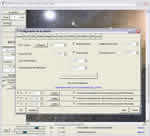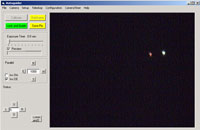::Satourne::

Software
Image Acquisition
My favourite software to acquire images is Audela. It is not a well-known software but is well worth a try. Its main advantage is that it is completerly customizable and you can even change the interface completely to create your own. It is open-source and free.
It supports many cameras, webcams, DSLRs and telescopes. The interface is in several languages and if need be you can ask questions on Audela's website forums. Here is a screenshot:
Autoguiding
After many trials and errors I was finally able to apply autoguiding successfully. Here are my main recommandations if you want to try autoguiding. First of all, you should have a mount capable of supporting 2 telescopes in parallel. In my setup, one telescope is fitted with a Toucam Webcam modified for long exposures and the other telescope has a Canon DSLR. The total weight of this equipment must not be too much for your mount. For instance, with my Vixen GP-DX mount, the total weight of my equipment is about 9 kg : that's still OK for astrophotography but I think it's the maximum.
You must connect the guide port of your mount to the serial port (also called COM port) of the PC. Then you establish the connection between the guiding software and your mount.
Here are a few practical tips:
- The software I use to control the mount so that it is autoguided is the excellent freeware Guidemaster. It can be used with webcams and various off-the-shelf CCD cameras. It is very rather intuitive and I recommend it.
- The first thing to to before autoguiding is carefully align the mount. I have a Vixen GP-DX mount and I use the polar finder to align it followed the drift align procedure. This site explains very clearly the drift align procedure. Remember: the aim is to have a well aligned mount, not a perfectly aligned one.
- You should now run Guidemaster, focus your guide scope so that you can see stars after clicking on the preview button of Guidemaster. The aim is to align the webcam sensor so that when you stop the mount from tracking, the stars drift horizontally. Press the Stop button of the mount remote control and see in which direction the stars drift. Rotate the webcam accordingly by trial and error until the stars drift horizontally. Now we know that the West is on the right site of the image.
- Now, you have to click on one star in the field, choose an exposure time (start with 1 second) and see if the red cross remains on that star. If you see that the star drifts, you should click in the Reverse E-W or N-S check boxes and try again. Wait at least one minute in that case to see if Guidemaster now successfully track the guide star.
- In my case, I had to click in the Reverse E-W check box, wait about one minute and the guide star was then completely fixed in the window. The mount was guided for as long as I wanted and I could shoot images with any duration :-) Thank you Guidemaster!
Image Processing
The software I use most often to process my images is Iris. It is a very effective freeware and Christian Buil's website (the author of the software) is very informative when it comes to understand how to use the program. For instance, I find this webpage very useful because it explains the processing workflow in details.
To process my images, I generally follow the webpage I just mentioned and export the final image as a TIF or BMP image that I open in Photoshop or the Gimp. There I apply various processing such as noise removal, layer combination, sharpening, etc. to get the final result.
I will detail all these steps later.

